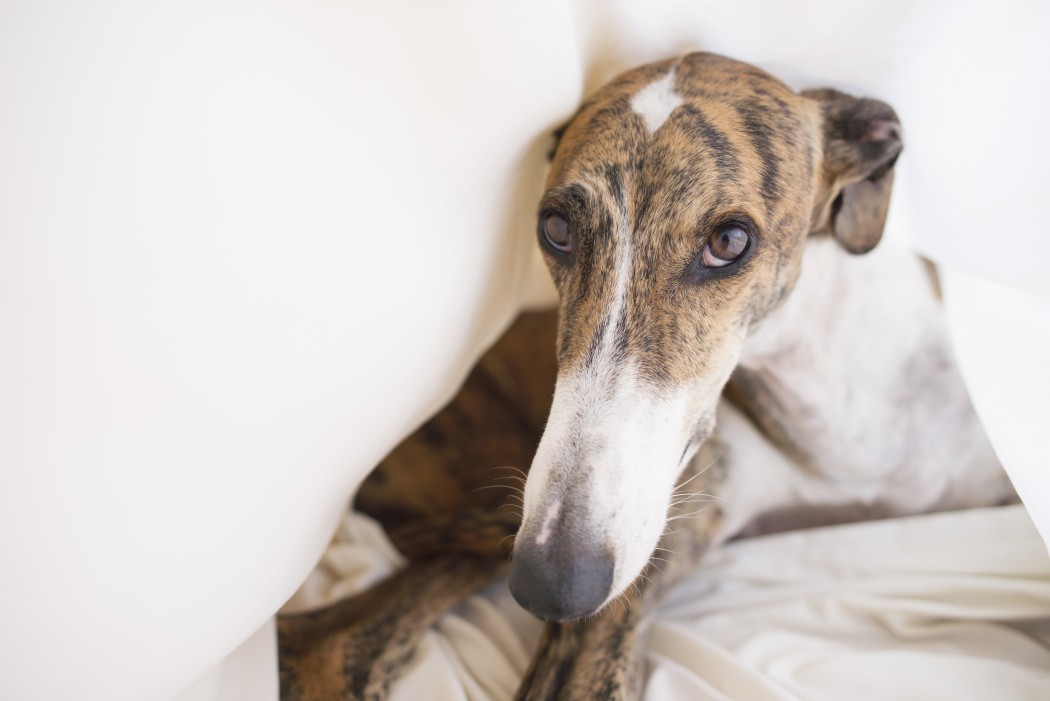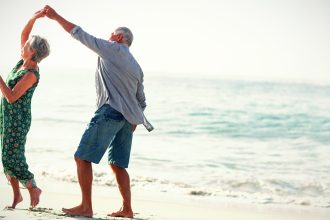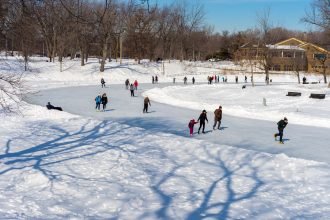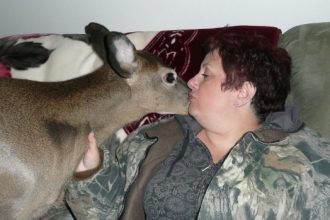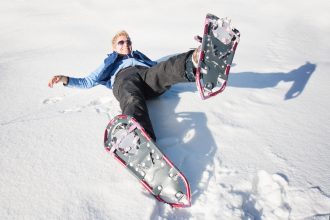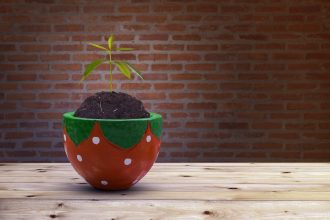Retirement is about indulging in those activities that you never had time for when you were trying to keep up with mortgage payments, driving the kids to and from after-school sports, and responding to work emails once they had gone to bed. By the time you retire, the kids have likely flown the coop, the mortgage is paid off, and the only emails you’re receiving are flight promos and tacky chain letters from old friends. And while slowing down might sound ideal, giving up that much responsibility all at once can be a bit jarring. Maybe you miss the companionship of your coworkers, or realize just how much you loved tending to the kids—even if they did drive you nuts most days.
But there is a happy medium: a dog can be the perfect solution to keeping you company and giving you something to take care of—without completely taking over your life. They’ll also help you take care of yourself. Numerous studies have found that dogs can improve your health and longevity. They not only help you stay active, but research has shown that cuddling with your pup can decrease the production of stress hormones like cortisol. It’s also been proven that they make you happier, contributing to feelings of well-being and combating loneliness—not that we needed science to back that one up! And whether you plan to spend your time travelling, volunteering, or just napping, there’s a pooch for every post-work lifestyle.
If you want to get in shape and spend more time outside

Photo by DragoNika/Shutterstock.com
If you spent at least 40 hours per week sitting at a desk for the past 40 years, chances are you’re hoping to change that. What you’ll notice, though, is that having more time doesn’t necessarily make it any easier to get off the couch. It also doesn’t guarantee you’ll get your heart pumping once you do. But you know what will? A high-energy dog. Get a pooch that requires lots of play and loves to run, and you’ll be forced to fit more exercise into your schedule—or risk having your shoes eaten by an under-stimulated pup. Lots of dogs enjoy activity, but the natural-born runners include labrador retrievers, boxers, brittany spaniels, German shorthaired pointers, weimaraners, border collies, vizslas, Australian and German shepherds, and rhodesian ridgebacks. These dogs don’t just have energy and endurance, they’re also low-maintenance and obedient, so they’ll stick with you along the trail.
If you want to travel

Photo by Agoxa/Shutterstock.com
Owning a dog doesn’t mean you have to forfeit travel time, it just means you have to plan ahead a little more. There are lots of great dog-sitting options out there these days, and depending on what type of vacation you’re going on, you could even bring your dog with you. All it takes is a little additional research to find pet-friendly airlines, destinations, and hotels. Depending on whether you want bring your precious pooch along or not, you’ll want to either look for a dog that doesn’t mind being left alone or one that’s good at adapting to new environments. Border terriers, Newfoundlands, English bulldogs, English setters, mastiffs, basset hounds, flat-coated retrievers, and bloodhounds all tend to be emotionally stable dogs, which means they’re not likely to freak out when exposed to new and exciting situations or environments. And while no dog wants to be left alone (and no owner wants to leave them) if it’s an absolute must, basset hounds, chihuahuas, French bulldogs, malteses, shar peis, and whippets are all low-key dogs that are likely to deal with time apart best.
If you have grandchildren

Photo by Andrea Obzerova/Shutterstock.com
If you’re going to be spending lots of time with grand kids, or perhaps you’re even planning to be the regular sitter, some dogs are more suited to being around children than others. While kids should always be taught to treat animals with respect, some breeds are better than others at dealing with young ones who might not pick up on cues that they don’t want to play. Some breeds are also less likely to get upset when all of your hugs and kisses are given to the kids rather than them. The key is to not just get a dog that’s friendly, but also one that is patient and doesn’t get jealous easily. According to the American Kennel Club, English bulldogs, beagles, Newfoundlands, golden retrievers, labrador retrievers, soft coated wheaten terriers, weimaraners, bull terriers, and boxers all share these traits, which is why the organization dubbed them the “best dogs for kids.”
If you want to volunteer

Photo by Hysteria/Shutterstock.com
Volunteering is an excellent way to spend retirement, and it’s even something you can do with your dog. Through organizations like Therapeutic Paws of Canada, you can register your pup and make regular visits to hospitals, residences, and schools, providing a loving animal to those in need. Of course if you’re interested in getting involved with this organization, or one like it, you’ll need a low-maintenance pooch that mixes well with people. But friendly can also equal jumping or giving endless kisses, which doesn’t work for everyone, so they should also be easy to train. Some of the friendliest and easy-to-train breeds include labrador retrievers, German shepherds, greyhounds, St. Bernards, and French bulldogs.
If you’re planning to downsize

Photo by Fongleon356/Shutterstock.com
Maybe selling the house was part of your retirement plan all along, or maybe years of maintaining a 2000-square-foot space, filled with closets of stuff you don’t use, has left you with the urge to simplify your lifestyle. It’s one of the very reasons the tiny house movement has gained so much momentum over the past couple of years. If you’re moving to a smaller place, you might want to consider a smaller breed of dog, too—it’s amazing how much room one extra body can take up. Downsizers will want to consider chihuahuas, miniature dachshunds, miniature pinschers, beagles, pugs, and Boston terriers. These dogs aren’t just relaxed, but they also all weigh less than 10 kg, so they won’t take up much space.
If you’re picky about keeping your place clean

Photo by Rita Kochmarjova/Shutterstock.com
On muddy spring days keeping your dog clean can be tougher than potty training a toddler, but the never-ending chore that comes with being a dog owner is without a doubt cleaning up its hair. If you don’t want to pull out the vacuum every other day, or maybe even find it in your food from time to time, choose wisely. Even on the coldest days of winter, there will be hair coming out of your collie, German shepherd, or Bernese mountain dog. But you won’t have to worry about sweeping up clumps of hair if you go for a short-haired breed or one that doesn’t shed at all (yes they do exist!). Giant schnauzers, Irish water spaniels, and standard poodles all fit the bill, but if you’re looking for something a little smaller, why not try a bichon frise, maltese, yorkshire terrier, miniature schnauzer, shih tzu, or miniature poodle.
If you don’t want to do much of anything

Photo by Sergio Boccardo/Shutterstock.com
If all you’ve dreamed about is slowing down and loafing around the house, there are dogs suited to that lifestyle, too. Any small breed would be the obvious choice here, especially pugs, bulldogs (English and French), chihuahuas, havaneses, and brussels griffons, but if you’re partial to big dogs, there are lots of lazy ones. In fact, some of the biggest breeds out there are low-energy, including greyhounds, St. Bernards, Bernese mountain dogs, and bullmastiffs. These dogs tend to get short bursts of energy, so a small game of fetch is usually enough to satisfy them. A lazy dog is also perfect if you want to dive into more personal projects—whether it’s learning to crochet or launching a side business—but you still want someone to keep you company, and maybe give you a break now and then.
Also on RNR:
https://youtu.be/Si4w4dNB0wM

